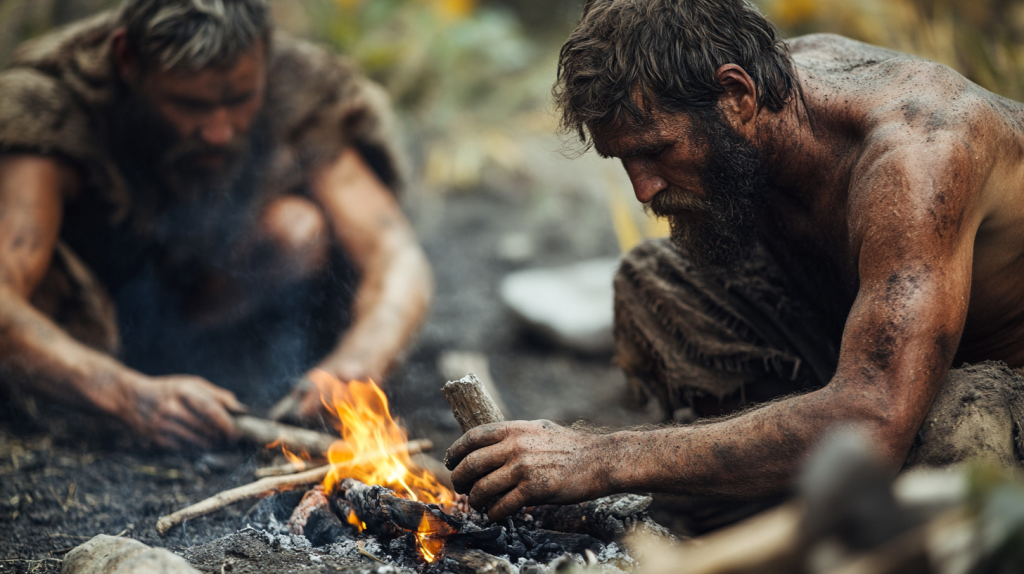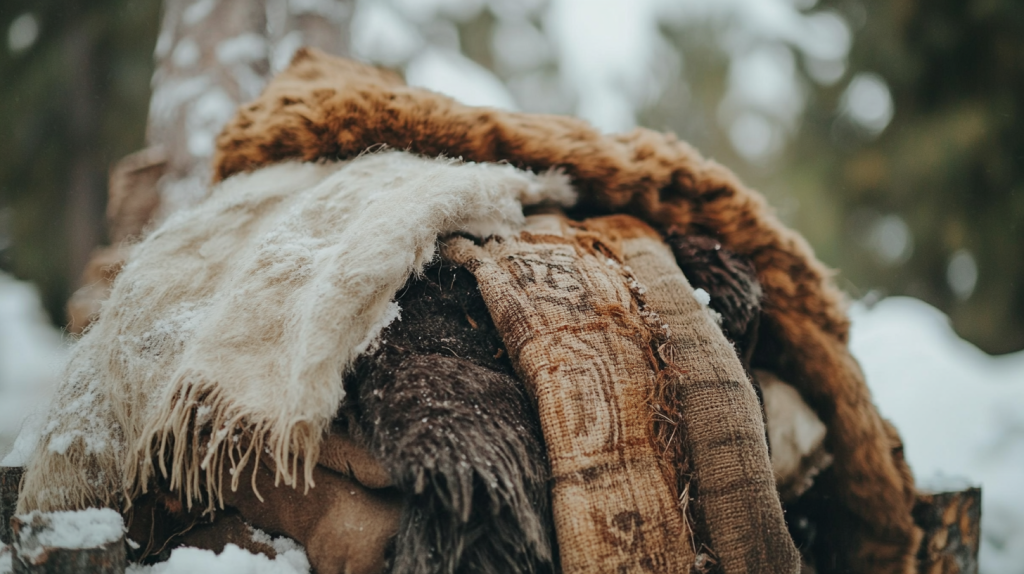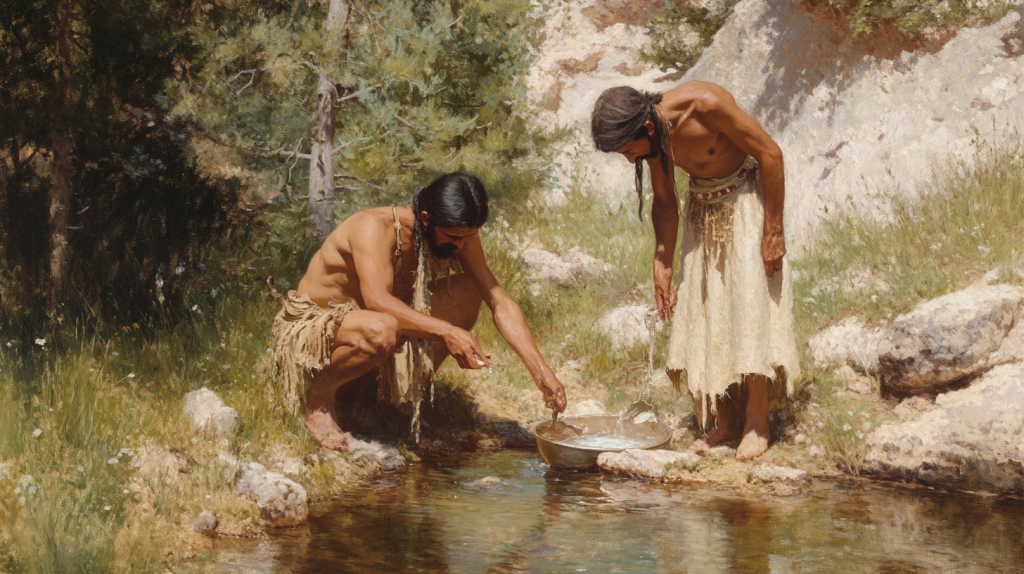It’s easy to take modern comforts for granted, but imagine living tens of thousands of years ago, without any of the technology we rely on today. Back in prehistoric times, survival meant mastering a range of skills that seem almost alien to us now. These abilities weren’t just useful—they were absolutely essential to staying alive. From hunting for food to building shelters and navigating the landscape, prehistoric humans had to rely on knowledge passed down through generations. Their environment was harsh, unpredictable, and full of dangers. What were these essential skills, and how did our ancestors use them to thrive in such conditions? Let’s take a look at 13 skills that played a vital role in their day-to-day lives, some of which might surprise you.
1. Flint Knapping

Flint knapping was the art of shaping stone tools, like hand axes, spearheads, and arrowheads. This was crucial for hunting, defense, and even basic tasks like cutting. Early humans became experts at finding the best types of stones, such as flint or obsidian, and crafting sharp, durable tools. Without metal, stone tools were their only option, making flint knapping an absolute must for survival.
2. Fire Starting

Fire wasn’t just about warmth—it provided safety, cooked food, and acted as a tool to shape materials. Prehistoric people mastered the skill of starting fires without matches or lighters, often using friction techniques like rubbing sticks together or striking stones to create sparks. Being able to reliably start a fire could mean the difference between life and death, especially in colder climates.
3. Animal Tracking

Tracking animals was key to successful hunting. Prehistoric hunters had to read signs in the environment to locate prey—whether it was hoof prints, broken branches, or disturbed earth. This knowledge also helped them avoid predators. Understanding animal behaviour, habitats, and migration patterns allowed early humans to follow and hunt their food sources more effectively.
4. Foraging for Edible Plants

Knowing which plants were safe to eat and where to find them was vital for a balanced diet. Prehistoric foragers could identify edible berries, roots, leaves, and nuts, while also avoiding poisonous varieties. This knowledge was often passed down through generations, and failure to recognise the right plants could lead to illness or death.
5. Shelter Building

Building shelters was crucial for protection from the elements and predators. Early humans learned to construct sturdy, weatherproof shelters using materials available in their environment—branches, leaves, animal skins, and even bones. In colder climates, they developed techniques like building insulated structures with snow or earth, which could keep them warm in extreme conditions.
6. Navigating by the Stars

Without maps or compasses, prehistoric people used the stars to navigate across vast distances. They understood how the position of stars and the movement of the sun and moon could guide them. This skill was essential for migration, following herds, or finding their way back to camp after a long hunt.
7. Crafting Clothing from Animal Skins

In colder environments, crafting clothing was essential for warmth and survival. Prehistoric people developed the ability to tan and process animal hides to make clothing, shoes, and blankets. These garments helped protect against harsh weather and insects, providing a layer of defence against the environment.
8. Tool Repair and Maintenance

Tools were hard to make, so keeping them in good condition was a priority. Prehistoric people were skilled at sharpening blades, reattaching spear points, and maintaining their tools to ensure they could be used for as long as possible. This wasn’t just about efficiency; broken tools could mean the loss of a food source or even safety.
9. Fishing with Handmade Gear

While hunting was crucial, fishing also played a big role in providing food. Early humans created spears, hooks, and nets to catch fish in rivers and along coastlines. Fishing required patience and precision, along with knowledge of local water bodies and the behaviour of different fish species.
10. Group Communication and Cooperation

Survival wasn’t a solo mission; cooperation was key. Early humans had to develop complex communication methods, often through gestures, sounds, and eventually early forms of language. These skills allowed them to plan hunts, share resources, and work together to defend their community from threats.
11. Herbal Medicine Knowledge

Prehistoric people couldn’t just pop to the chemist when they were ill or injured. Instead, they relied on their deep understanding of medicinal plants. They knew which herbs could treat wounds, ease pain, or reduce fevers. While trial and error likely played a part, this knowledge helped them survive injuries and illnesses in a time when modern medicine didn’t exist.
12. Making Weapons for Hunting and Defense

Weapons were essential for both hunting and protection against predators or rival groups. Early humans made spears, bows and arrows, and clubs using stone, wood, and bone. These weapons required skill to craft and maintain, but they greatly increased the chances of survival by allowing humans to take down large animals and defend their territory.
13. Water Sourcing and Purification

Finding water was an everyday challenge, especially in arid regions. Prehistoric humans had to locate reliable sources of fresh water, such as streams or underground springs. In some cases, they even learned how to filter or purify water by letting sediment settle or boiling it when they had the means.
18 Everyday Things Amish Women Aren’t Allowed to Do

The Amish culture is known for its simple way of life and adherence to traditional values. While this lifestyle may seem appealing to some, there are certain restrictions that Amish women face that most modern women do not. Take a look at these things that we take for granted that are off-limits to Amish women.
Read More: 18 Everyday Things Amish Women Aren’t Allowed to Do
Ellen has been obsessed with logic puzzles, jigsaws, and cryptograms since she was a kid. After learning she was taught how to play chess wrong by a family friend (so they could win), she joined her school chess club and the rest is history.

